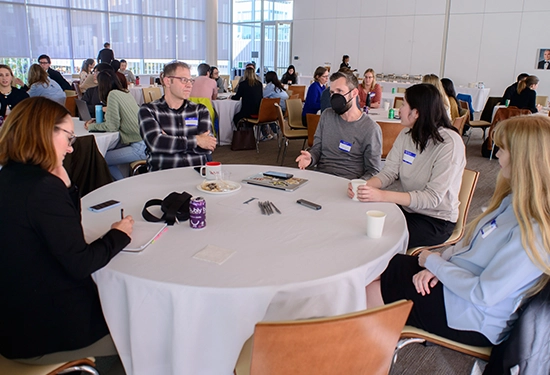
On October 28, 2024, the Breakthrough T1D Centre of Excellence at the University of British Columbia (UBC) held its third annual meeting on UBC campus in Vancouver to discuss progress to date as well as the team’s ambitious plans for Years 4 and 5 of the research program.
During Year 3, the team made several breakthroughs, achieved excellent progress against research milestones, and established goals and deliverables for the next two years of funding. Updates from across the Centre’s three research themes in year 3 include:
Theme 1: Building better beta cells for islet replacement therapy, led by Dr. Francis Lynn
To help study how stem cell-derived islets develop and function in experimental settings, the team has created and characterized multiple human pluripotent stem cell lines that glow green when they develop into insulin-producing beta cells and red when they develop into glucagon-producing alpha cells. Experiments now underway will shed light on how these two key islet cell types interact, and how each cell type influences the function of the other. Work in this theme in Year 3 was also focused on finding factors that could protect transplanted stem cell-derived islets from stress and death. Using imaging techniques, and comparing islets from organ donors with stem cell-derived islets, the team discovered 6 factors that significantly reduce beta cell death. In the coming year, work in Theme 1 will follow up on the protective factors as well as pursue a new approach to develop “designer” beta cells using gene editing techniques. Together, this work is advancing the development of high-quality islet replacement products that will survive and function long-term once transplanted.
Theme 2: Protecting insulin-producing beta cells from immune attack, led by Dr. Megan Levings
A key focus in Theme 2 is developing regulatory T cell (Treg) therapy as a better way to protect islet transplants, compared with conventional immunosuppression. In Year 3, the team built on results from Years 1 and 2 to develop a new method to grow Tregs in the lab that will improve how long they survive and function after they are infused into patients with T1D, and are protecting the invention for future commercial interests. In year 4, the team will build on these findings to develop islet-targeted Tregs and test them in preclinical models of T1D. The team also advanced its development of a lipid nanoparticle (LNP)-based approach for T1D, in collaboration with UBC spin-off company Integrated Nanotherapetics (recent recipient of a new Breakthrough T1D industry grant). In Year 3, the team extended findings that their LNP-based therapy could prevent T1D a mouse model of the disease and, remarkably, also showed that the treatment could also reverse established diabetes. During year 4, the team will optimize delivery of this new therapy and conduct additional preclinical testing.
Theme 3: Targeting and monitoring beta cell stress, led by Dr. Jim Johnson
During year 3, the team identified over 150 different proteins that can protect beta cells from T1D-inducing cellular stress caused by things such as increased demand for insulin, inflammation, infection or chemicals. The team also uncovered new information about EIF2A, a previously identified “hub” for the cellular stress response, moving the team closer to developing new approaches that can protect beta cells from harm. In year 4, the team will continue to study what happens when beta cells are under stress to help zero in on new therapeutic targets. Theme 3 also advanced work on biomarkers of beta cell function that, pending further testing and validation in Year 4, may be useful as a new tool to measure the progression of T1D and response to novel therapies being developed in other themes.
“The Centre team has made outstanding progress in its first three years,” said Francis Lynn, Associate Professor, UBC Department of Surgery & Biomedical Engineering. “The momentum at the annual meeting was tangible as we discussed wins, challenges, and future plans for collaboratively accelerating our research towards cures.”





New Centre-associated awards announced
During the annual meeting, the Centre also took the opportunity to celebrate and welcome the third J. Andrew McKee Postdoctoral Fellow, funded at the Centre by Breakthrough T1D and Canada’s Stem Cell Network, Dr. Alyssa Weinruch, who has joined the lab of Dr. Jim Johnson to contribute to Theme 3 projects. Learn more about Dr. Weinruch on our blog.
To drive further innovation and bring new high-risk, high-reward pilot projects into the research program, the Centre has also run a seed grant competition for three consecutive years. At this annual meeting, we heard updates from Year 2 seed grant holders, and an announcement of projects funded through the third and final competition – which in addition to seed grants, awarded sapling grants to support earlier seed grant projects with promise.
Dr. Jan Dutz and collaborators are using their 2023 seed grant to test a modified version of methotrextate – a drug that has long been used for treatment of other immune diseases – to see if it can prevent progression of T1D in preclinical models. Thus far, the group has optimized the novel formulation of methotrexate and are awaiting the outcome of preclinical experiments currently in progress. The other 2023 seed grant awardee, Dr. Marc Horwitz, worked with this team to investigate how the complex relationship between viruses and the gut microbiome can influence susceptibility to T1D, and discovered a key role for short-chain fatty acids – produced in the gut upon digestion of high-fiber foods – in protecting from T1D.
2024 seed and sapling grant funding recipients and their associated projects are:
- Dr. Nicole Krentz, together with Theme 3 lead Dr. Jim Johnson, will study whether a protein called RREB can protect beta cells from autoimmunity.
- Dr. Ramon Klein Geltink, together with postdoctoral fellow Dr. Lauar de Brito Monteiro, will use a cutting-edge method called SCENITH to assess beta cells and immune cells to gain new clues as to how progression of T1D could be slowed or stopped.
- Dr. Laura Evgin, together with Theme 2 lead Megan Levings, plans to engineer CAR Treg cells designed to wipe out the harmful immune cells that kill beta cells in T1D, and test their efficacy in a preclinical model of the disease.
- Dr. Hongshen Ma (recipient of a 2022 seed grant from the Centre) will work with Theme 1 lead Francis Lynn and use new sapling grant funding to develop nanotechnology-based approaches that will enable measurement of hormone production by individual islets, alongside other characteristics, providing new tools that can help to examine and improve islet replacement products for T1D.
- Dr. Dan Luciani (recipient of a 2022 seed grant from the Centre) was awarded a sapling grant to build on initial findings about a protein called TFEB that he hypothesizes can be manipulated to increase the function and resilience of stem cell-derived beta cells for therapy.
Lived Experience Advisory Group
The Centre’s T1D Lived Experience Advisory Group established in 2023 had a key role during this year’s annual meeting. The Advisory Group’s role is to integrate the voices of people with lived experience of T1D into the Centre’s work to ensure their interests and concerns are heard and translated into research aims and knowledge mobilization activities. This year, the Advisory Group led an interactive workshop entitled “Bridging the gap”, during which members of the research team had a chance to connect with people with lived experience of T1D. Discussion focused on personal perspectives on how to define a cure for T1D, and what this would mean for those living with the disease, resulting in insightful and impactful learnings for all attendees.
“Connecting with Centre researchers and sharing the real experiences of living with T1D was powerful,” said Ben Mammon, a member of the Centre’s T1D Lived Experience Advisory Group. “I’m grateful for the ongoing progress and dedication their teams bring to the T1D community. Knowing that our shared stories can help drive innovations to improve lives is inspiring and motivating.”
The future
The overall goal of the Centre is to drive new T1D cure therapies towards clinical trials. As the Centre begins year 4, the team is laser-focused on accelerating key projects towards clinical translation, identifying commercial receptors for relevant technologies, and publishing their findings. They will also continue to support multidisciplinary activities for the Centre’s many trainees, including skills-focused workshops and a mentorship program, and engage the Lived Experience Advisory Group increasingly as projects move towards the clinic. In the long term, the Centre team looks forward to leveraging UBC’s Advanced Therapeutics Manufacturing Facility , a new facility that will be co-directed by Dr. Megan Levings and that is currently in planning on UBC campus. This facility is expected to propel Vancouver to the forefront of cell therapy innovation and clinical research.
“I have attended all three annual meetings for the Centre, and this year’s event really delivered something special,” said Heather Miller, parent of a person with T1D and long-time Breakthrough T1D supporter. “The progress shared seemed like it was on a different level – the advances feel closer than ever to reality. This is so meaningful to us having lived with T1D in our family for so long.”
Read more about the Centre here or at UBC’s dedicated webpage at https://breakthrought1d.med.ubc.ca/
For information about how to support the Breakthrough T1D Centre of Excellence at UBC, please visit: https://breakthrought1d.ca/get-involved/accelerate/



